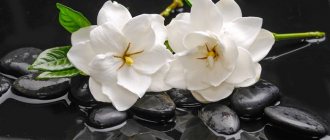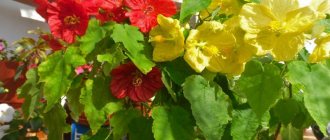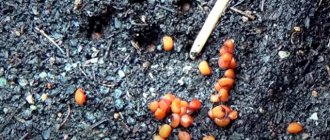Hydrangea (Hydrangea) is a member of the genus of flowering plants in the Hydrangeaceae family. This genus includes approximately 80 species, and is represented by shrubs and small trees. Under natural conditions, this plant is found in South and North America, Japan, China and other countries of South and East Asia. This plant was named after one of the princesses of the Holy Roman Empire. And systematic botanists called it “hydrangea,” which is translated from ancient Greek as “a vessel with water.” This is due to the fact that the plant is very moisture-loving.
Hydrangea appeared in indoor culture in European countries in 1820. Later, it began to be cultivated in open ground. As soon as flower growers and gardeners began to grow hydrangea, experts began breeding. Thanks to them, many varieties and varieties were born. Today, this beautifully flowering plant can be found not only in the garden, but also in a pot on the terrace, veranda or balcony.
Types and varieties of indoor hydrangea
Hydrangea is a plant whose height reaches one and a half meters. Belongs to the type of subshrubs. Has spreading leaves. They have small notches along the very edge. It is distinguished by very large inflorescences that reach up to 30 cm in length.
Varieties have been bred to create a large palette of colors. Let's look at the most common ones for home floriculture.
- Tree-like. A shrub whose height reaches 3 meters. The leaves are large and fleshy. Bright green hue. The flowers form a spherical sphere and reach a diameter of 25 cm. Flowers are most often colored milky or beige. One of the most unpretentious varieties.
- Large-leaved. The length reaches 2 meters. Suitable for both home growing and greenhouse growing. The leaves are quite large. The shoots are always light green. The variety is resistant to cold, so even in the winter season it feels great on a cold window.
- Paniculata. Looks like a large spreading shrub or small tree. The height reaches 6 meters. The leaves have an elongated shape. And the shoots turn brown with age. The plant is resistant to cold. The inflorescences gradually form a small pyramid. They have shades from milky to blue. By autumn, the flowers acquire a reddish or even brown tint.
Flowers also differ in the color that is inherent in them during flowering. There are varieties:
- red sensation;
- Early Blue;
- Europe;
- star;
- linear and so on.
However, the color of the inflorescences is affected not only by the variety, but also by the composition of the soil. For example, if it is sour, then a blue tint appears in the flowers. If it is more alkaline, then the pigment is pink or red. If the soil is neutral, then you will get boiling white flowers with milky splashes.
RELATED MATERIALS
Hydrangea is spectacular both in single and group plantings. The main thing is that the soil is rich and...
2
Paniculata hydrangea is one of the most popular and beloved crops by gardeners. We specifically...
3
Tree hydrangea appeared in my garden unexpectedly - a neighbor gave me cuttings. After a couple...
Benefits of container gardening
Stable decorative effect. For container design...
3
We are used to planting summer flowers in flowerpots; with them, a veranda, patio or gazebo is certainly transformed. But …
2
20
Once on March 8th I was given an unusually beautiful bush of large-leaved hydrangea with bright...
How to choose hydrangea in a store
It is believed that it is better to purchase flowers in specialized stores.
The first thing to do is look at the stem. It should be dense, elastic, and have an expensive green color. There should be no brown or yellow growths on the leaves. They should be juicy and bright green. If the hydrangea leaves are limp, dry at the edges, or have white or yellow spots on them, you should refuse to purchase.
Carefully examine the hat of flowers. It should be dense, rich, bright colors. If the cap is pale, and the flowers begin to fall when touched lightly, it means that the plants did not receive enough nutrients.
There is one general rule that should be applied to choosing a flower - it should look healthy, nourished and moisturized.
Helpful information
Hydrangea domestica is the name of a perennial subshrub. The height of the plant can reach 1 meter, and the flowering period is quite long and lasts from spring to autumn.
The leaves are 10-15 cm long and have an ovoid shape and a serrated edge. The inflorescences are quite large, ball-shaped, reaching up to 35 cm in diameter. The uniqueness of the plant is the ability to change the color of the inflorescences depending on the composition of the soil:
- Sour – blue color.
- Neutral – white/cream shade.
- Alkaline – lilac/pink.
At the same time, the petals of the inflorescences have no color, but the sepals are richly colored, which gives the hydrangea a decorative appearance.
Care and replanting after purchase
It is not recommended to replant hydrangea immediately after purchase. The plant must get used to new conditions. Give her 2 weeks to 1 month to adapt.
In the future, the transplant procedure should be carried out at least once every 3–4 years.
If you ensure annual replanting into larger pots, you can ensure the fullest blooms your hydrangea can produce. The roots of the plant grow in width, so the volume of the pot must match.
Choose a pot that is slightly larger than the diameter of the one you purchased the flower in.
While the plant adapts, you can gradually acquire components for the substrate. You will need 1 part sand, two parts peat, two parts deciduous soil and 4 parts turf soil. All this is mixed and poured into the pot.
Do not forget that during the first stages of life in a new room, hydrangeas will require additional care in the form of fertilizing. It is better to buy mineral fertilizer intended specifically for indoor flowering plants. You can buy it in a specialized store. It is important not to overdo it, so dilute the fertilizer according to the instructions and water the flower in the amount indicated on the package.
Hydrangea does not like direct sunlight, but loves warmth and diffused light. Therefore, it is better to place it on a shaded window.
As soon as the hydrangea gets stronger, you can take care of it and replant it.
At first after purchase, namely, the first two weeks, it is better not to overwater the plant. It is necessary to moisten the soil as it dries. But spraying leaves and flowers from a spray bottle is highly recommended. This procedure must be performed once every two days.
Decorative characteristics
Hydrangeas are subshrubs from the group of perennial flowering garden crops, with beautiful large leaves with a pointed edge, growing in the form of a multi-stemmed compact spherical bush. The color of the leaves is rich green, two types of flowers - large sterile and small fruit-bearing, are collected in a spherical inflorescence, similar to large caps.
The color of hydrangeas ranges from snowy white to cream, lilac, pinkish, blue, light green shades, which look like light spots in any interior.
Most often, the most capricious type of hydrangea - large-leaved - is grown in indoor culture, but there are also spectacular varieties of tree-like, petiolate and paniculate hydrangeas.
In indoor cultivation, hydrangeas are much more compact than their garden counterparts, and thanks to selection, the flowering period is more extended, and in some varieties the intensity of unusual colors is much higher than that of garden plants.
Caring for hydrangea at home
Lighting for indoor hydrangea
If you choose the right lighting for a flower, it will delight you with its color for a long time.
It is important to choose the right place here. This is necessary so that there is an abundance of color. However, the leaves and flowers of the plant should not be exposed to direct sunlight. Therefore, you need to place the flower at a distance of approximately 3–4 m from the window. In this case, the plant will feel ideal.
Temperature for hydrangea
In terms of temperature, the plant is capricious. The ideal room temperature is between 18 and 23 °C. It is ideal for hydrangeas. The plant should not be exposed to drafts, as it may die.
In winter, this flower can be placed in a room where the temperature is 10 °C. Then the hydrangea will go into a short hibernation and accumulate strength until the new summer season.
Don't forget about watering. The water used to irrigate the land must be at room temperature. Under no circumstances should you use water from the refrigerator.
Watering hydrangea
Caring for hydrangeas in terms of watering should include regularity.
- Hydrangea loves fresh water very much. It can be classified as a moisture-loving plant.
- For irrigation, settled water that is at room temperature is ideal.
- The hotter it is outside the window, the more often you need to irrigate the soil. Don't forget to spray the flowers and leaves with a spray bottle. However, you should not be overzealous with watering. It needs to be renewed as the soil dries out. If you overwater it, the hydrangea can easily rot.
- If the hydrangea leaves begin to turn yellow, this means that it lacks acid. Therefore, sometimes you need to give her a shower with acidic water. To do this, mix 5–8 drops of lemon juice in one liter of water.
Air humidity
Hydrangea loves humidity in the air. Therefore, when the heating season begins and the air is dry, the plant suffers greatly. Therefore, do not forget to spray it with a spray bottle.
If you have a humidifier, place the plant pot nearby. It is enough for hydrangea to spend about half an hour next to a humidifier to stock up on moisture for several days ahead.
Brief description of cultivation
- Bloom . It starts in April and ends in November.
- Illumination . The light should be bright, but at the same time diffused. To do this, it is enough to place the bush near a south-facing window (at a distance of 200–300 cm).
- Temperature regime . During the growing season - about 20 degrees, and during the dormant period - from 7 to 10 degrees.
- Watering . During the summer months, the bushes need plenty of frequent watering. In spring and autumn, water more rarely and moderately. During the dormant period, the soil is moistened rarely and sparingly.
- Humidity . Requires high air humidity. On hot days, the bush should be moistened as often as possible with a spray bottle.
- Fertilizer . Feeding is carried out during the period February–October. To do this, use a mineral complex for flowering plants (heathers, azaleas and rhododendrons), and apply fertilizer to the soil twice a month. In winter, the plant does not need fertilizer.
- Rest period . Observed in December and January.
- Transplant . It is carried out only for indoor hydrangea every year, and its life expectancy is from 3 to 4 years.
- Trimming . In the autumn, when the bushes have faded, weakened stems must be cut off, and powerful shoots must be shortened by ½ part of the length. With the onset of spring, cut out any weak stems that have become very elongated during the dormant period.
- Reproduction . By cuttings, dividing the bush and seed method.
- Pests . Spider mites and aphids.
- Diseases . Downy mildew and gray mold.
Feeding
In the spring and summer, Hydrangea enters the active stage. At this stage, for enhanced growth, she will need additional amounts of useful minerals and organic substances. Therefore, it is at this stage that it is worth using organic fertilizer.
Unfortunately, if you neglect such care, the plant will stop blooming and develop further.
When watering several times a week, you need to add a few drops of potassium permanganate to the water.
Winter care does not involve the use of fertilizing.
Gardeners say that gibberellin solution is successful in caring for hydrangeas. Approximately 0.1 g per 1 liter of water is used. Thanks to the composition, hydrangea quickly enters the flowering state.
The unique property of hydrangea
This wonderful flower is interesting for its unusual ability to change the color of its petals. You can use this to create a shade with your own hands that harmonizes with the interior of the room. Hydrangea accumulates aluminum, thanks to which its flowers acquire the desired color.
For example, the petals will turn pink if you add lime to the soil. Adding aluminum sulfate will provide a blue color. Acidic soil will give colors brightness and richness, neutral soil will give a noble pallor. For oxidation, use peat, coniferous soil or sawdust. For alkalization, it is better to use ash, lime and chalk.
You can change the color of your hydrangea yourself using little tricks.
To get blue flowers, add potassium alum to the water for irrigation, about 8 grams per 1 liter of water. You can also spray the bush with a solution of 50 g of aluminum citrate per 1 liter of water.
Some gardeners claim that hydrangea with white petals does not change its color due to the properties of the soil or the addition of any substances. Allegedly, only varieties with blue and pink flowers are subject to such changes. Well, a good reason to experiment at home. Moreover, in this way you will not harm the flower itself.
Trimming
The pruning procedure is mandatory in order to maintain the attractive appearance of the plant. For this procedure you will need a well-sharpened knife or pruning shears. The cut should be sharp and even.
During pruning, weak leaves and stems that have begun to dry out or rot are removed. It is also necessary to trim the top of the plant in order to form a more luxuriant crown.
It is ideal to prune twice a year. This is in the fall, when the flowering period has passed, you need to remove weakened leaves and in the spring, when you need to remove weakened shoots.
During the flowering period, the pruning procedure stops. It begins when the first faded flowers or leaves appear. They are the ones that need to be removed so that the plants do not rot.
Rest period
The dormant period of hydrangea begins in the cold season. As a rule, during autumn frosts. Plants go dormant, begin to consume less moisture and stop blooming. To allow the plant to gain strength before the next season, it must be placed in a room with a temperature of no more than 10 degrees. Do not forget about watering as the soil dries out.
Hydrangea will resume its vitality in late March - early April, when the sun begins to actively warm up.
Reproduction
Hydrangea can be propagated in various ways. Some are more, some are less effective. Let's look at the nuances of each method.
Propagation by cuttings
Propagation by cuttings is the easiest way. The most favorable time for this is January or February.
Take a closer look at the root shoots. Cut the cuttings so that there are no more than three nodes on the branch. Their length should be approximately 8 cm. All leaves should be removed from the bottom of the cut root. The upper leaves should be shortened exactly by half.
The cut on the lower side must be treated with a special root stimulator, which is sold in specialized stores.
The cuttings must be planted in a specially prepared substrate, which consists of peat and sand. Provide maximum humidity, which will promote rapid root formation. Ideal temperature is up to 20 degrees.
Some housewives advise covering the cuttings with special glass jars. However, once a day you need to leave the plant to air for several hours, removing the glass protection. The plant needs constant moisture, so the soil needs to be watered and the leaves should be sprayed with a spray bottle.
After just one month, the cuttings can be planted on prepared peas.
Reproduction by dividing the bush
Dividing the bush is another common method. However, you need to act with caution so as not to spoil the entire bush.
The shoots are evenly shortened. The bush is divided into several parts, carefully freeing the roots. Parts of the plant need to be distributed into different pots into a specially prepared adversary and watered.
You can apply a mulching procedure, which is designed to root the plants faster. It is better to carry out this procedure in the spring so that by autumn the plant feels comfortable in the pot.
Propagation by seeds
When growing seeds, the procedure must be carried out already in February.
- Prepare the soil, which consists of turf and humus.
- Additionally, admixtures of peat or sand can be added to it.
- Purchase special containers that are designed for growing.
- Scatter hydrangea seeds on top. They do not need to be buried in the ground.
- Water the soil well.
- Then you need to cover the container with cling film or glass. Every day you need to ventilate the crops and moisten them with a spray bottle. Remember to keep the soil mostly moist, but not wet.
- As soon as the first shoots appear, the cling film can be removed.
When two leaves appear, they need to be picked in a container.
Reproduction by layering
This type of propagation is best done in March. Used for plants that grow in open ground. However, it can also be used for home flowers.
- The soil around is dug up and compared.
- Small grooves are made to a depth of 2 cm. Approximately one shoot is placed in them. By the way, the shoots need to be cut off from the bottom of the bush.
- They are laid parallel to the ground and covered with earth.
- Then you need to constantly spray the area with a spray bottle to achieve adequate moisture.
- As soon as the roots appear, you need to make a constriction of soft wire. It is carried out in three turns.
- The more the wire is pressed, the faster roots will appear from this place.
By the end of summer, several months after the start of reproduction, several young shoots appear on the cuttings. Once they reach a height of 20 cm, they can be transplanted into a separate pot.
Lighting and placement
Hydrangeas belong to those garden crops that brighten up nooks and shaded areas. Their light requirements do not change even in indoor conditions: hydrangeas prefer to grow in secluded partial shade , in diffused light of medium intensity. This plant should absolutely not be exposed to direct sunlight , which will not only jeopardize flowering, but will also cause the leaves to lose their decorative properties.
But such requirements for a semi-shaded location also have a specific feature: with its love of seclusion, hydrangea also needs its uniformity: the light intensity should not change throughout the year , its decrease in the cold period can be disastrous for this crop. In winter, it is necessary to compensate for the seasonal decrease in light intensity by moving the plant to more illuminated places that were not suitable for it in summer due to their sunshine and brightness. Without such a rearrangement, hydrangeas will lack light in winter and not only lose their decorative value, but also weaken, becoming extremely vulnerable to diseases and pests.
When choosing a place where hydrangeas will be comfortable, do not forget about the need to provide them with enough space and access to circulating air.
Hydrangeas can only be placed in large or at least medium-sized rooms, in which the caps of their inflorescences and the massiveness of the bush will have a harmonizing effect on the surrounding space and will not obscure the perception of the room itself. But they should not be placed in small rooms and offices, even if the lighting of the given place is completely suitable for them: the lush beauty of the plants will visually narrow the space, and hydrangeas will not be comfortable in cramped spaces and they will be visually inferior in decorativeness to those plants that have been provided with sufficient space.
The love for free air is fully manifested in the need to ventilate rooms (only without creating drafts), and in the requirement to move plants to open spaces in the summer, to fresh air. Hydrangeas are most comfortable in cool places in the garden, on terraces or balconies with shade.
Diseases and pests
Hydrangea is prone to diseases, which form on it with surprising frequency.
- Gray rot. Appears on the leaves if you overdo it with moisture. Reduce watering and make it a rule to treat the flower with a special Bordeaux mixture.
- Spider mite. When the air is dry, on the contrary, spider mites or aphids appear on the plant. To destroy this scourge, you need to water the hydrangea with a soap solution or a special product from the store.
- Downy mildew. Appears at high humidity. Eliminated through the use of drugs that contain copper.
- Nematode. A nightmare for hydrangeas. If the plant is affected by more than 50%, then, unfortunately, it cannot be saved and will have to be thrown out.
Possible problems
Pests and diseases
If the humidity is excessively high, this can lead to damage to home hydrangeas by gray rot. To save the plant, spray it with a solution of Bordeaux mixture. Also, high humidity can cause the development of downy mildew. In this case, the bush is treated with a solution of a fungicidal or copper-containing agent.
If the air in the room is too dry, aphids or spider mites may settle on the plant. To get rid of them, the bush is sprayed 2 times with a solution of Actellik or soap with a break of 7 days.
Hydrangea turns yellow
Hydrangea foliage may begin to turn yellow for the following reasons:
- poor or infrequent watering;
- the plant needs nitrogen;
- the bush is affected by chlorosis (this occurs due to the substrate in the container being too alkaline).
To save a subshrub, simply correct existing care errors.
Hydrangea is drying
Sometimes gardeners are faced with the fact that the plant begins to dry out. This may happen due to:
- violations of the irrigation regime;
- not enough frequent moisturizing from a spray bottle;
- untimely fertilizing;
- injury to the root system during transplantation.
Hydrangea falls
Most often, the leaves begin to fly off after they dry out. Remember that this is a moisture-loving plant, and therefore you need to water and moisten it with a spray bottle regularly.
Hydrangea doesn't bloom
Most often this is due to a warm winter. A bush that is exhausted after abundant long flowering cannot restore its strength in a warm and bright place. It requires coolness and darkness during its dormant period. In such a place, the hydrangea should stay from 70 to 80 days. A basement or dark room is suitable for wintering the bush. Cut off all its foliage, shorten powerful stems by ½ part, and cut weak stems at the root. The prepared bush along with the pot is transferred to a cool place and laid on its side. The crop is sent for wintering in December, and in February it already begins to come to life. If everything is done correctly, the bush will bloom magnificently and for a long time every year.
Why doesn't indoor hydrangea bloom? | toNature.Info
Preparing for winter
Before sending the hydrangea into hibernation, it must be prepared on the eve of the onset of cold weather.
The plant cannot overwinter in Russian winter conditions without appropriate insulation. This also applies to indoor hydrangeas. You should not place hydrangea on an open balcony where the temperature is below 0 degrees. The ideal temperature for wintering hydrangea is +10 °C.
Before you prepare your hydrangea for winter, you need to do the appropriate pruning. To do this, faded flowers, dry or, conversely, too limp leaves are removed. If there are individual shoots that have grown in length but are very dry, or vice versa, they show signs of rot, they also need to be cut off.
After the procedure is completed, the plant must be brought to a new watering regime. Now you need to water less often so that the hydrangea does not rot by winter.
Prepare a room to place the flower. The temperature in it should be between 8–15 degrees, no higher and no lower. Place the plant in this room and make sure that it will not be exposed to drafts.
Temperature
To ensure proper care of indoor hydrangea at home, maintain an optimal temperature near the pot. From spring to autumn, a range from +20 to +22 °C is desirable for it. At this time, it is important to regularly ventilate the room so that the plant receives as much fresh air as possible. Place your home hydrangea on the balcony or in the garden, but choose places for the flower that are protected from drafts and sharp gusts of wind.
In the fall, when the plant begins its dormant period, move your pet to a dark basement or cellar with a temperature of +7 to +10 °C. It is advisable to do this before the end of November, otherwise the plant will not have time to recover and will not bloom next year. Before sending the crop to rest, remove all the leaves and shorten the shoots by half the length, and cut out small weak branches at the root. Place the pot with indoor hydrangea on its side and store the flower in this position until February.
If you do not have a basement, then you can save the plant on a glazed balcony, where the temperature fluctuates between +4 °C. To ensure that the flower can easily withstand the cold, shorten its shoots by two-thirds of the length, and then cover the crop with spruce branches and wrap it in non-woven material. In February, when the buds appear on the hydrangea, return it to the room and place it in its usual place.
Changing the color of hydrangea
Not all hydrangea owners are happy with its color. You may not know, but it's easy to change.
- Make the soil more alkaline. Then bright pink flowers will appear along with a blue or white tint.
- If you make the soil more acidic or regularly water the plants with water and a few drops of lemon juice, you can achieve a blue tint.
- If the soil is in normal condition and the plant is regularly watered with water with the addition of a small amount of potassium permanganate, then the hydrangea will acquire a white tint.
Transfer
Indoor hydrangea is transplanted annually in early spring immediately after the buds awaken. If transplanted later, the plant will not bloom. After purchase, regardless of the time of year, the hydrangea is transferred, partially replacing the transport soil.
Choosing the right pot and soil
The soil for hydrangea should be slightly acidic, light, breathable and at the same time nutritious and moisture-absorbing. A mixture of leaf and coniferous soil, peat, river sand and perlite (3:1:2:2:1) is considered optimal. All components except sand and perlite are subjected to heat treatment. The sand is thoroughly washed. Perlite is considered a sterile medium and does not require mandatory processing. The soil is thoroughly mixed until smooth and poured with a slightly pink solution of potassium permanganate. A ready-made mixture is suitable for azaleas and rhododendrons.
The diameter of the pot is selected so that about 10 cm remains from the trunk to the sides. The container should be deep and stable, with drainage holes to drain excess water. The diameter of the new pot should be 2 sizes larger than the previous one. It is better to avoid unglazed containers - pathogenic microorganisms accumulate in their pores.
Step-by-step transplant process
When replanting hydrangea, follow the following algorithm:
- Immediately after waking up from hibernation, the bush is removed from the old pot.
- The earthen ball is shaken off a little, allowing some of the soil to fall off on its own. Do not handle the roots with your hands, so as not to injure them.
- A layer of expanded clay or crushed polystyrene is placed at the bottom of the new pot, and soil is poured.
- Install the bush so that it does not have to be buried.
- Add soil to the sides without compacting it. Water, and after precipitation, add more if necessary.
After planting, the hydrangea is placed in a brightly lit place and waits for the leaves to appear.
Difficulties in growing hydrangea
Leaves are drying
If the leaves of a hydrangea dry out, it means that it does not have enough moisture. Give preference to watering with a spray bottle, which should be done daily. Also, do not forget about ventilating the room.
Watering should be done as the soil dries out. Turn on a humidifier near the hydrangea for several hours.
The leaves are falling
If leaves fall, then, unfortunately, this is also evidence of improper care. Falling from dryness indicates a lack of moisture and the proper amount of nutrients.
If the leaves simply wither and fall off, most likely the hydrangea is not getting enough sunlight and warmth. Therefore, raise the room temperature to the desired level.
What to do if the hydrangea has withered
If the hydrangea has wilted by 40%, you can try to revive it. To do this, water it with water containing potassium permanganate. Additionally, copper sulfate and other fertilizers are diluted and poured into the soil.
If it was not possible to rehabilitate the hydrangea, you should say goodbye to it. And the housewife needs to analyze what caused the plant to wither so quickly.
Hydrangea does not bloom, what to do
The plant will bloom if the following conditions are met.
- When the rest period ends.
- It was properly prepared for winter.
- Receives the proper amount of nutrition and feeding.
- All flower diseases were removed.
If you missed any of these points, then, most likely, this is why the hydrangea does not bloom. However, the reason may lie in completely different factors. For example, the roots were damaged during transplantation. The plant directs all its forces to restore their integral structure and not wither. Therefore, flowering is temporarily delayed.
Many people call hydrangea a capricious plant. After all, to care for it you need to very correctly select the necessary standards for temperature and humidity indicators. However, a housewife who is not afraid to mess with hydrangea and is ready to care for it both summer and winter can decorate her home with an incredible color that will delight you all spring, summer and autumn.
Humidity
Hydrangea can easily tolerate normal humidity in an apartment, but will be grateful to you for periodically washing the leaves in the shower to remove dust. The leaves can also be wiped with a damp cloth.
If the flower is located close to a working battery, it is good to spray the leaves. In spring and summer, you can spray hydrangea as desired, not too often.
- Important: spray the leaves, not the flowers, and use settled water.











